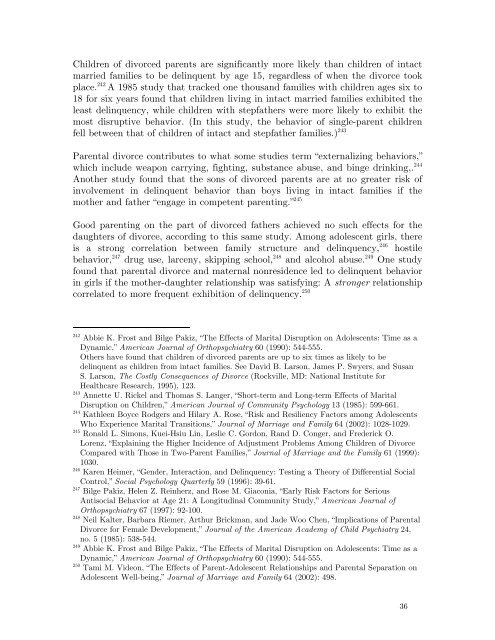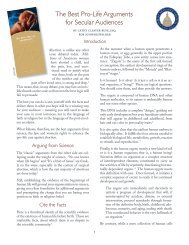The Effects of Divorce on Children - Family Research Council
The Effects of Divorce on Children - Family Research Council
The Effects of Divorce on Children - Family Research Council
You also want an ePaper? Increase the reach of your titles
YUMPU automatically turns print PDFs into web optimized ePapers that Google loves.
<strong>Children</strong> <str<strong>on</strong>g>of</str<strong>on</strong>g> divorced parents are significantly more likely than children <str<strong>on</strong>g>of</str<strong>on</strong>g> intact<br />
married families to be delinquent by age 15, regardless <str<strong>on</strong>g>of</str<strong>on</strong>g> when the divorce took<br />
place. 242 A 1985 study that tracked <strong>on</strong>e thousand families with children ages six to<br />
18 for six years found that children living in intact married families exhibited the<br />
least delinquency, while children with stepfathers were more likely to exhibit the<br />
most disruptive behavior. (In this study, the behavior <str<strong>on</strong>g>of</str<strong>on</strong>g> single-parent children<br />
fell between that <str<strong>on</strong>g>of</str<strong>on</strong>g> children <str<strong>on</strong>g>of</str<strong>on</strong>g> intact and stepfather families.) 243<br />
Parental divorce c<strong>on</strong>tributes to what some studies term “externalizing behaviors,”<br />
which include weap<strong>on</strong> carrying, fighting, substance abuse, and binge drinking,. 244<br />
Another study found that the s<strong>on</strong>s <str<strong>on</strong>g>of</str<strong>on</strong>g> divorced parents are at no greater risk <str<strong>on</strong>g>of</str<strong>on</strong>g><br />
involvement in delinquent behavior than boys living in intact families if the<br />
mother and father “engage in competent parenting.” 245<br />
Good parenting <strong>on</strong> the part <str<strong>on</strong>g>of</str<strong>on</strong>g> divorced fathers achieved no such effects for the<br />
daughters <str<strong>on</strong>g>of</str<strong>on</strong>g> divorce, according to this same study. Am<strong>on</strong>g adolescent girls, there<br />
is a str<strong>on</strong>g correlati<strong>on</strong> between family structure and delinquency, 246 hostile<br />
behavior, 247 drug use, larceny, skipping school, 248 and alcohol abuse. 249 One study<br />
found that parental divorce and maternal n<strong>on</strong>residence led to delinquent behavior<br />
in girls if the mother-daughter relati<strong>on</strong>ship was satisfying: A str<strong>on</strong>ger relati<strong>on</strong>ship<br />
correlated to more frequent exhibiti<strong>on</strong> <str<strong>on</strong>g>of</str<strong>on</strong>g> delinquency. 250<br />
242 Abbie K. Frost and Bilge Pakiz, “<str<strong>on</strong>g>The</str<strong>on</strong>g> <str<strong>on</strong>g>Effects</str<strong>on</strong>g> <str<strong>on</strong>g>of</str<strong>on</strong>g> Marital Disrupti<strong>on</strong> <strong>on</strong> Adolescents: Time as a<br />
Dynamic,” American Journal <str<strong>on</strong>g>of</str<strong>on</strong>g> Orthopsychiatry 60 (1990): 544-555.<br />
Others have found that children <str<strong>on</strong>g>of</str<strong>on</strong>g> divorced parents are up to six times as likely to be<br />
delinquent as children from intact families. See David B. Lars<strong>on</strong>, James P. Swyers, and Susan<br />
S. Lars<strong>on</strong>, <str<strong>on</strong>g>The</str<strong>on</strong>g> Costly C<strong>on</strong>sequences <str<strong>on</strong>g>of</str<strong>on</strong>g> <str<strong>on</strong>g>Divorce</str<strong>on</strong>g> (Rockville, MD: Nati<strong>on</strong>al Institute for<br />
Healthcare <strong>Research</strong>, 1995), 123.<br />
243 Annette U. Rickel and Thomas S. Langer, “Short-term and L<strong>on</strong>g-term <str<strong>on</strong>g>Effects</str<strong>on</strong>g> <str<strong>on</strong>g>of</str<strong>on</strong>g> Marital<br />
Disrupti<strong>on</strong> <strong>on</strong> <strong>Children</strong>,” American Journal <str<strong>on</strong>g>of</str<strong>on</strong>g> Community Psychology 13 (1985): 599-661.<br />
244 Kathleen Boyce Rodgers and Hilary A. Rose, “Risk and Resiliency Factors am<strong>on</strong>g Adolescents<br />
Who Experience Marital Transiti<strong>on</strong>s,” Journal <str<strong>on</strong>g>of</str<strong>on</strong>g> Marriage and <strong>Family</strong> 64 (2002): 1028-1029.<br />
245 R<strong>on</strong>ald L. Sim<strong>on</strong>s, Kuei-Hsiu Lin, Leslie C. Gord<strong>on</strong>, Rand D. C<strong>on</strong>ger, and Frederick O.<br />
Lorenz, “Explaining the Higher Incidence <str<strong>on</strong>g>of</str<strong>on</strong>g> Adjustment Problems Am<strong>on</strong>g <strong>Children</strong> <str<strong>on</strong>g>of</str<strong>on</strong>g> <str<strong>on</strong>g>Divorce</str<strong>on</strong>g><br />
Compared with Those in Two-Parent Families,” Journal <str<strong>on</strong>g>of</str<strong>on</strong>g> Marriage and the <strong>Family</strong> 61 (1999):<br />
1030.<br />
246 Karen Heimer, “Gender, Interacti<strong>on</strong>, and Delinquency: Testing a <str<strong>on</strong>g>The</str<strong>on</strong>g>ory <str<strong>on</strong>g>of</str<strong>on</strong>g> Differential Social<br />
C<strong>on</strong>trol,” Social Psychology Quarterly 59 (1996): 39-61.<br />
247 Bilge Pakiz, Helen Z. Reinherz, and Rose M. Giac<strong>on</strong>ia, “Early Risk Factors for Serious<br />
Antisocial Behavior at Age 21: A L<strong>on</strong>gitudinal Community Study,” American Journal <str<strong>on</strong>g>of</str<strong>on</strong>g><br />
Orthopsychiatry 67 (1997): 92-100.<br />
248 Neil Kalter, Barbara Riemer, Arthur Brickman, and Jade Woo Chen, “Implicati<strong>on</strong>s <str<strong>on</strong>g>of</str<strong>on</strong>g> Parental<br />
<str<strong>on</strong>g>Divorce</str<strong>on</strong>g> for Female Development,” Journal <str<strong>on</strong>g>of</str<strong>on</strong>g> the American Academy <str<strong>on</strong>g>of</str<strong>on</strong>g> Child Psychiatry 24,<br />
no. 5 (1985): 538-544.<br />
249 Abbie K. Frost and Bilge Pakiz, “<str<strong>on</strong>g>The</str<strong>on</strong>g> <str<strong>on</strong>g>Effects</str<strong>on</strong>g> <str<strong>on</strong>g>of</str<strong>on</strong>g> Marital Disrupti<strong>on</strong> <strong>on</strong> Adolescents: Time as a<br />
Dynamic,” American Journal <str<strong>on</strong>g>of</str<strong>on</strong>g> Orthopsychiatry 60 (1990): 544-555.<br />
250 Tami M. Vide<strong>on</strong>, “<str<strong>on</strong>g>The</str<strong>on</strong>g> <str<strong>on</strong>g>Effects</str<strong>on</strong>g> <str<strong>on</strong>g>of</str<strong>on</strong>g> Parent-Adolescent Relati<strong>on</strong>ships and Parental Separati<strong>on</strong> <strong>on</strong><br />
Adolescent Well-being,” Journal <str<strong>on</strong>g>of</str<strong>on</strong>g> Marriage and <strong>Family</strong> 64 (2002): 498.<br />
36




